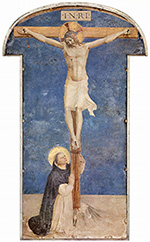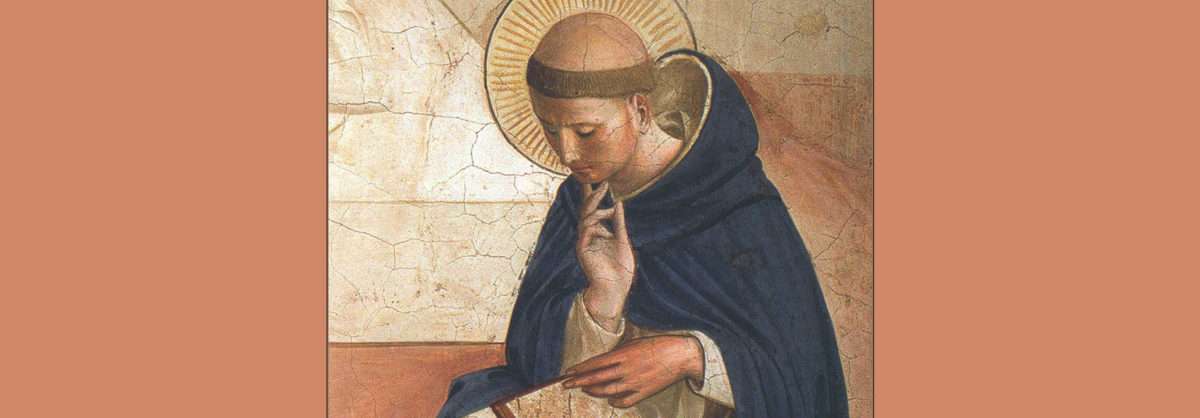About today’s saint, Dominic de Guzman, Butler’s Lives of the Saints tells us that “he left no writings”—a rather unusual situation for the founder of a major order.
Yet Fra Angelico, one of Dominic’s spiritual sons, left us a painting that tells us more than homilies or treatises. It shows Dominic kneeling at the foot of the cross, his hands grasping the rough-hewn, blood-stained beam. Dominic gazes up to his dying Lord with a look that is calm—as if there were no other place to be.
 In fact, for Dominic, there was no other place to be. All of Dominic’s actions flowed from this central point. He got through life by clinging with all his strength to Christ. The cross was his life-raft, a tranquil center in an ocean of uncertainty, violence, and confusion.
In fact, for Dominic, there was no other place to be. All of Dominic’s actions flowed from this central point. He got through life by clinging with all his strength to Christ. The cross was his life-raft, a tranquil center in an ocean of uncertainty, violence, and confusion.
Although he founded an order that played and continues to play a key role in building up the Church, Dominic was no strategist. In all things, he sought to follow Christ—which meant, in practice, a total openness to whatever challenges God would send his way, a body-and-soul commitment to love in the face of all difficulties.
Such reckless abandon to God’s will is of the essence of sanctity. Saints don’t try to be saints. They try only to follow Christ.
Dominic’s story began in his native Castile, today part of Spain. The son of devout parents, he studied theology in his teens and was recruited by the bishop of Osma to become a canon, a resident cleric, at the cathedral. In his early thirties, he was chosen by the bishop to accompany him on a diplomatic trip through Languedoc, a region in southern France where the Albigensian heresy held sway.
The Albigensians adhered to the spiritual teachings of Christ, but not the ones that touched upon the material order. In fact, in Albigensian thought, the body was the locus of evil. For the Albigensians, we become good by transcending the body. Not surprisingly, the Albigensians detested sex and childbearing. The sacraments with all their physical “messiness”—water and oil and bread—were off-limits too.
The Albigensian heresy was deeply attractive to people because it promised a certainty of salvation if one followed its rules. The Albigensian “Perfects” lived austere, abstemious lives, fasting from food and drink and forsaking sexual relations. They were the gurus of their day—and their purity and otherworldliness took many in.
It is said that one night Dominic met one of the Albigensian adherents in an inn. He stayed up the entire night in conversation with the man, expounding on the true faith. As dawn broke, the man repudiated his heresy. This encounter deeply impressed Dominic. When his diplomatic mission came to an end, he decided to remain in Languedoc to preach the Gospel. He spent the next ten years as a missionary there, teaching and preaching, counseling and consoling. His heart was fed by assiduous nighttime prayer.
Through repeated contact with the Albigensians, Dominic gradually formed an idea of the sort of missionaries who could continue such arduous work. He decided to train preachers to meet the challenge of the heresies head-on. Unlike monks, who made a vow of stability, or diocesan priests, who remain with their parishes, these men— called friars—would be poor and itinerant. They were to be free to move from community to community as the need arose.
Legend has it that Dominic’s own mother had had a vision of her son even before he was born: he was represented as a dog with a burning torch in its mouth. This child, his mother came to understand, had been sent to set the world ablaze with the fire of the Gospel.
And this is really all that Dominic himself wanted to do. Like all the Church’s great founders, Dominic had no plan to found an order. He was simply following Christ, responding to the needs of his time. He was ready and willing to go wherever he was called, to give whatever was asked. For him, there was only the Master’s plan, unfolded daily through the circumstances of his life.
We see this same desire to abandon oneself to Divine Providence in the life of Elizabeth Ann Seton. After her conversion, Elizabeth attempted to begin a school for girls in her home, a plan that backfired when her Episcopalian friends and family suspected her of trying to convert the girls to Catholicism.
Her future was uncertain. A widow, she had young children, and her support system of Protestant friends and family was beginning to fray due to her conversion to the Church. Yet, at this moment, Elizabeth refused to craft a plan. She clung to Christ, certain that he would not fail her. When it was suggested that she start a school for girls as a woman religious, she responded at once. She allowed God to work in her.
Amazingly, this devoted mother opened her heart to children not her own with simplicity and abandon. Elizabeth wrote to her friend Julia Scott, “To speak the joy of my soul at the prospect of being able to assist the poor, visit the sick, comfort the sorrowful, clothe little innocents and teach them to love God!” Such abandon was the source of her peace.
For both St. Dominic and St. Elizabeth Ann Seton, the one certainty was the call of Christ. It was not up to them to figure out the how of it. It was only theirs to follow.
The feast day of Saint Dominic is August 8th.
LISA LICKONA, STL, is Assistant Professor of Systematic Theology at Saint Bernard’s School of Theology and Ministry in Rochester, New York, and a nationally-known speaker and writer. She is the mother of eight children.
This reflection was previously published. Click here to view all Seton Reflections.
Image: CC 4.0
